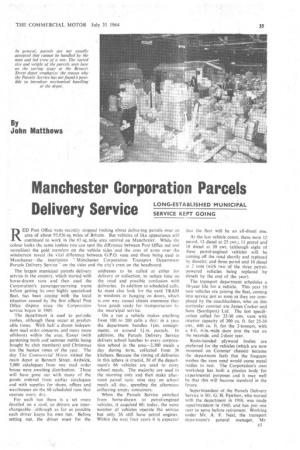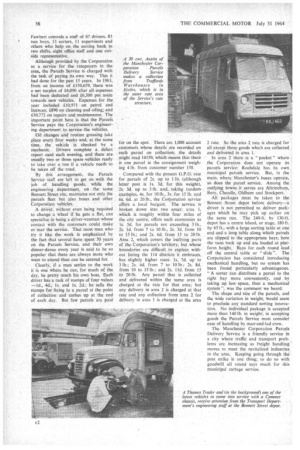Manchester Corporation Parcels Delivery Service
Page 37

Page 38

If you've noticed an error in this article please click here to report it so we can fix it.
By John Matthews
LONG-ESTABLISHED MUNICIPAL SERVICE KEPT GOING ED Post Offiee vans recently stopped rushing about delivering parcels over an area of about 93,926 sq. miles of Britain. But vehicles of like appearance still continued to work in the 65 sq. mile area centred on Manchester. While the colour looks the same (unless you can spot the difference between Post Office red and vermilion) the gold transfers on the vehicle sides and the coat of arms over the windscreen reveal the vital difference between G.P.O. vans and those being used in Manchester—the inscription Manchester Corporation Transport Department Parcels Delivery Service" on the sides and the city's crest on the headboard.
The largest municipal parcels delivery service in the country, which started with horse-drawn vans and then used the Corporation's passenger-carrying trams before getting its own highly specialized fleet, has been coping with the local situation caused by the first official Post Office dispute since the Corporation service began in 1905.
The department is used to per:odic rushes, although these occur at predictable times. With half a dozen independent mail order concerns, and many more offshoots within the area. Easter (with gardening tools and summer outfits being bought by club members) and Christmas are the busiest times of the year. The day The commercial Motor visited the main depot at Bennett Street, Ardwick, 5.000 catalogues from one mail order house were awaiting distribution. These will have gone out with many of the goods ordered from earlier catalogues and with supplies for shops, offices and warehouses on the 60 scheduled runs that operate every day.
For each run there is a set route detailed on a card, so drivers are interchangeable--although as far as possible each driver keeps his own run. Before setting out, the driver must list the addresses to be called at either fordelivery or collection, to reduce time on the road and possible confusion with deliveries. In addition to scheduled calls. he must also look for the card TRAM in windows or hanging on doors, which is _one way casual clients announce they have goods ready for transportation by the munipal service.
On a run a vehicle makes anything from 100 to 200 calls a day: in a year the department handles 11-m. consignments, or around 1.4 m. parcels. In addition, the Parcels Delivery Service delivers school lunches to every corporation school in the area-2,300 meals a day during term, collected from 30 kitchens. Because the timing of deliveries in this sphere is crncial, 30 of the department's 66 vehicles are used to carry school meals. The majority are used in the morning only and then make afternoon parcel runs; nine stay_ on school meals all day. spending the afternoon collecting empty containers.
When the Parcels Service switched from horse-drawn to petrol-engined vehicles, it acquired 66; today, the same number (3 f vehicles operate the service but only 26 still have petrol engines. Within the next four years it is expected
that the fleet will be an all-diesel one.
At the last vehicle count, there were 12 petrol, 12 diesel at 25 cwt.; 11 petrol and 18 diesel at 30 cwt. (although eight of these petrol-engined vehicles will be coming off the road shortly and replaced by diesels); and three petrol and 10 diesel at 2 tons (with two of the three petrolpowered vehicles being replaced by diesels by the end of the year).
The transport department schedules a 10-year life for a vehicle. This year 10 new vehicles are joining the fleet, coming into service just as soon as they are completed by the coachbuilders, who on this particular contract are James Cocker and Sons (Southport) Ltd. The last specification called for 25-30 cwt. vans with interior capacity of 300 Cu. ft. for 25-30 cwt., 440 Cu. ft. for the 2-tonners, with a 4-ft. 6-in.-wide door into the van on the nearside, and 2-door rear.
Resin-bonded plywood bodies are preferred for the vehicles (which are now mounted on Commerchassis) because the department feels that the frequent washes the vans need would cause metal bodies to rust. The Corporation's own workshop has built a plastics body for experimental purposes and it may well he that this will become standard in the future.
Superintendent of the Parcels Delivery Service is Mr. G: H. Fawbert, who started with the department in 1916, was made superintendent in 1945, and has just one year to serve before retirement. Working under Mr. A: F. Neal, the transport department's general manager, Mr.
Fawbert controls a staff of 67 drivers, 83 van boys, 13 sorters, 11 supervisors and others who help on the sorting bank in two shifts, eight office staff and one outside representative.
Although provided by the Corporation as a service for the ratepayers in the area, the Parcels Service is charged with the task of paying its own way. This it had done for the past 15 years. In 1963, from an income of £150,659;there was a net surplus of 14,090 aftei all expenses had been deducted and £6,500 put aside towards new vehicles. Expenses for the year included £10,971 on petrol and licences; £890 on cleaning and oiling; and £10,772 on repairs and maintenance. The important point here is that the Parcels Service pays the Corporation's engineering department to service the vehicles.
Oil changes and routine greasing take place every four weeks and, at the same time, the veh:cle is checked by a mechanic. Drivers complete a defect report card each evening, and there are usually two or three spare vehicles ready to take over a run if a vehicle needs to be taken off the road. , By this arrangement, the Parcels Service staff are left to get on with the job of handling goods, while the engineering department, on the same Bennett Street site, maintains not only the parcels fleet but also buses and other Corporation vehicles.
A driver, without even being required to change a wheel if he gets a flat, can specialize in being a driver-vanman whose contact with the customers could make or mar the service. That most men who try it like the work is emphasized by the fact that several have spent 50 years on the Parcels Service, and their own dinner-dance every year is said to be so popular that there are always more who want to attend than can be catered for.
Clearly, if a man settles to the work it is one where he can, for much of the day, be pretty much his own boss. Each driver has a rack of stamps of four values —1d., 4d., Is. and Is. 2d.; he sells the stamps for fixing to a parcel at the point of collection and cashes up at the end of each day, But few parcels are paid
for on the spot. There are 1,000 account customers..whose details are recorded on each parcel on collection; the details might read 14150, which means that-there is one parcel in the consignment weighing 4th. from customer number 150..
. Compared with the present G.P.O. rate for parcels of 2s. up to 1 lb. (although letter post is ls. 3d. for this weight), 2s.. 3d. up to 3 lb. and, taking random examples, 4s. for JO lb., 5s. for 15 lb, and 6s. 6d. at 20 lb., the Corporation service offers a local bargain. The service is broken down into two areas: area 1, which is .roughly within four miles of the city centre, offers such economies as Is. 5d. for parcels not exceeding 3 lb., 2s. Id. from 7 to 10 lb., 2s, 3d. from 10 to 15 lb.; and 2s. 641. from 15 to 20 lb. Area 2, which covers the outlying parts of the Corporation's territory, but whose boundaries are difficult to explain without listing the 114 districts it embraces, has slightly higher rates: is. 7d. up' to 3 lb.; 2s. 4d, from 7 to ID lb.; 2s. 8d. from 10 to 15 lb.; and 2s. !Id. from 15 to 20 lb. Any parcel that is collected and delivered .within the same area is charged at the rate for that area; but any delivery in area 2 is charged at that rate and any collection from area 2 for delivery in area 1 is charged at the area 2 rate. So the area 2 rate is charged for all except those goods which are collected and delivered in area 1.
In area 2 there is a " pocket " where the Corporation does not operate its parcels service: Rochdale has its own municipal parcels service. But, in the main, where Manchester's buses operate, so does the parcel service. Among the outlying towns it serves are Altrincham, Bury. Cheadle, Oldham and Stockport.
All packages must be taken to the Bennett Street depot before delivery—a driver is not permitted to deliver pack-ages which he may pick up earlier on the same run. The 240-ft. by 130-ft. depot has a centre island, or stage, 180 ft. by 65 ft., with a large sorting table at one end and a long table along which parcels are slipped to the appropriate bays; here the vans back up and are loaded at .platform height, Bays for each round lead off the central table or " slide". The Corporation has considered introducing mechanical handling, but no system has been found particularly advantageous. "A sorter can distribute a parcel to the right bay more conveniently, and by taking up less space, than a mechanical system", was the comment we heard.
The shape and size of the parcels, and the wide variation in weight, Would seem to preclude any standard sorting innovation. No individual package is accepted more than 140 lb. in weight; in accepting goods the Parcels Service must consider ease of handling by man-and-lad crew.
The Manchester Corporation Parcels Delivery Service is a friendly service in a city where traffic and transport problems are increasing as freight handling moves to meet the revitalized industries in the area. Keeping going through the pest strike is one thing; to do so with goodwill all round. says much for this municipal cartage service.








































































































